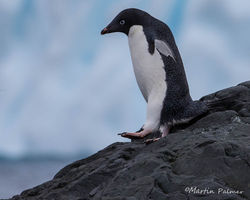Antarctic Peninsular
The final destination in the expedition was the Antarctic Peninsular. The 7th continent is quite inhospitable, even in the summer months. The weather reminded me of a cold Canadian winter day in Vancouver, BC. The temperatures hovered around freezing and there was always the risk of a snow storm. The scenery is breath taking. The land comprises of either jagged and sheer rock faces, or it is buried under a glacier. The Antarctic Peninsular coastline is covered by glaciers dipping there toes into the ocean, as they slowly slide off the land and into the water, creating fascinating floating seascapes. There are no expansive deltas or beaches on the peninsular for animals to colonize, as there are on the islands of South Georgia. The native animals must either live on the ice, such as the seals or look for small out cropping of rock, that due to protective rock formations and predominant weather patterns, tend to have less ice build up in the winter months.
It is the Chinstrap, Gentoo and Adélie penguins that inhabit these small rock out crops. With the exception of the Emperor penguins, penguins can't incubate their eggs on ice. The only nesting material on the peninsular are rocks. Penguins will carry small rock to the nests from the shore, or try to seal them from adjacent nests to enhance there own nest. This constant pilfering of rocks is quite comical to watch.
 |  |  |
|---|---|---|
 |  |  |
 |  |  |
 |  |  |
 |  |  |
 |  |  |
 |  |  |
 |  |  |
 |  |  |
 |  |  |
 |  |  |
 |  |  |
 |  |  |
 |  |  |
 |  |  |
 |  |


